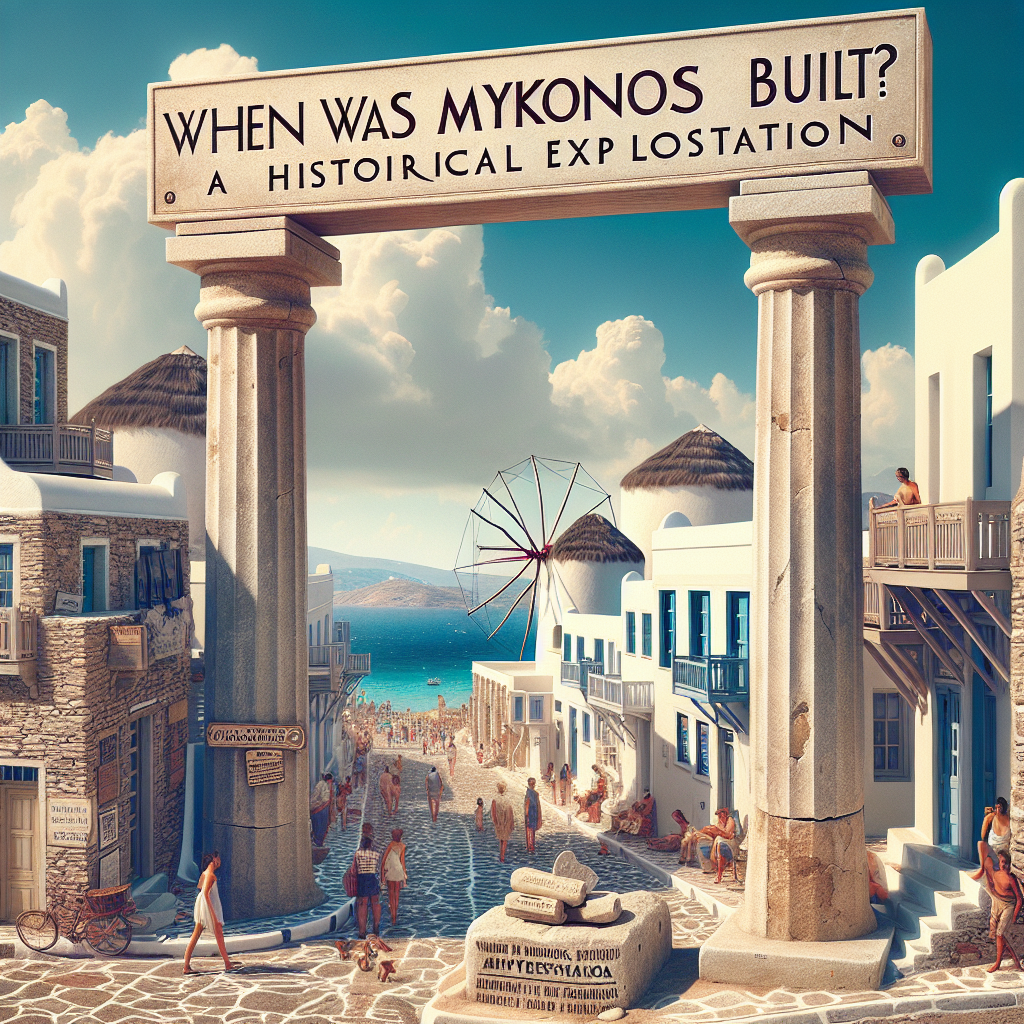 The sun-kissed island of Mykonos, with its azure blue waters, white-washed buildings and a vibrant party scene, is a paradise that draws thousands of tourists each year. However, there’s more to Mykonos than just beaches and parties. This stunning island holds a rich tapestry of history that stretches back thousands of years. So, when was Mykonos built? Let’s embark on a historical exploration to find the answer.
The sun-kissed island of Mykonos, with its azure blue waters, white-washed buildings and a vibrant party scene, is a paradise that draws thousands of tourists each year. However, there’s more to Mykonos than just beaches and parties. This stunning island holds a rich tapestry of history that stretches back thousands of years. So, when was Mykonos built? Let’s embark on a historical exploration to find the answer.
The Early Inhabitants: From 3000 BC
The origins of Mykonos can be traced back to the Neolithic Age around 3000 BC when it was first inhabited by the Carians, an ancient Anatolian people. However, the island truly began to flourish under the Ionians, who settled here in 1000 BC and are considered the first ‘real’ inhabitants.
The Classical Period: 500 BC – 323 BC
During this era, Mykonos became part of the Athenian Alliance, a maritime confederation formed to counter the Persian Empire. The island played a significant role in the Persian Wars, particularly in the historic battle of Artemision. It was during this period that the island’s infrastructure started to take shape, with the construction of buildings and temples.
The Hellenistic and Roman Periods: 323 BC – 395 AD
Following the death of Alexander the Great, Mykonos, like the rest of Greece, entered the Hellenistic Period. The island continued to prosper and was known for its strong agricultural sector. During the Roman era, Mykonos maintained its autonomy and continued to thrive.
The Byzantine Period: 395 AD – 1204 AD
With the fall of the Roman Empire, the Byzantine era began. Mykonos became a part of the Byzantine Empire, under which it enjoyed religious and artistic growth. The island is home to several Byzantine-era churches that stand as testament to this period.
The Venetian Rule: 1204 AD – 1537 AD
The Fourth Crusade led to the disintegration of the Byzantine Empire, and the Duchy of Naxos, including Mykonos, fell under Venetian rule. The island’s architecture, particularly the iconic Cycladic houses, owes much to this period.
The Ottoman Rule: 1537 AD – 1821 AD
The Venetian rule was followed by the Ottoman era, which lasted nearly four centuries. Under the Ottomans, Mykonos enjoyed a degree of autonomy and continued to prosper due to its strategic location. The island’s inhabitants were primarily engaged in maritime activities, leading to the growth of Mykonos as a commercial hub.
The Greek Revolution and Independence: 1821 AD – 1830 AD
The island played an active role in the Greek War of Independence against the Ottomans. Following the war, Mykonos became a part of the newly formed Greek State in 1832.
Modern Mykonos: 20th Century Onwards
The 20th century marked a significant shift for Mykonos as it transformed from a primarily agricultural society to a bustling tourist hotspot. The island’s stunning beaches, vibrant nightlife, and rich history have made it one of the most popular destinations in Greece.
Exploring Historical Mykonos Today
Today, the history of Mykonos is evident in its stunning architecture, ancient ruins, and charming old town. Some must-visit historical sites include:
- Panagia Paraportiani: A stunning Byzantine-era church.
- Delos: An uninhabited island nearby, renowned for its archaeological significance.
- Windmills of Mykonos: Iconic landmarks dating back to the 16th century.
- Mykonos Town (Chora): The island’s bustling capital filled with Cycladic houses.
So, when was Mykonos built? The answer isn’t straightforward as the island has been continuously inhabited, developed, and transformed over thousands of years. Each era has left its imprint, shaping Mykonos into the mesmerizing destination it is today.
Planning a trip to Mykonos?
Check out “Where to Stay in Mykonos in 2024” for top tips on the coolest areas and comfiest hotels, perfect for any travel style or budget. Get the inside scoop here and make your Mykonos adventure unforgettable!
Read Also:
5 Mykonos hotels near Paradise beach
Where to Stay in Mykonos on a Budget
The 15 Best Mykonos Hotels on the Beach
Mykonos vs Santorini. Which one is better to visit?
The 15 best Mykonos Hotels with Private Pools
Mykonos Nightlife Guide: The 20 best bars, night clubs and Beach clubs in Mykonos
Best area to stay in Mykonos
Where to stay in Mykonos: Beach or Town
Best 5 Star Hotels in Mykonos
Best time to visit Mykonos
Best Suite Hotels in Mykonos
Best Mykonos Hotels near Nammos
Best Mykonos Hotels near Town
Best Mykonos Hotels for Yoga
Mykonos to Athens by Ferry or Flight
